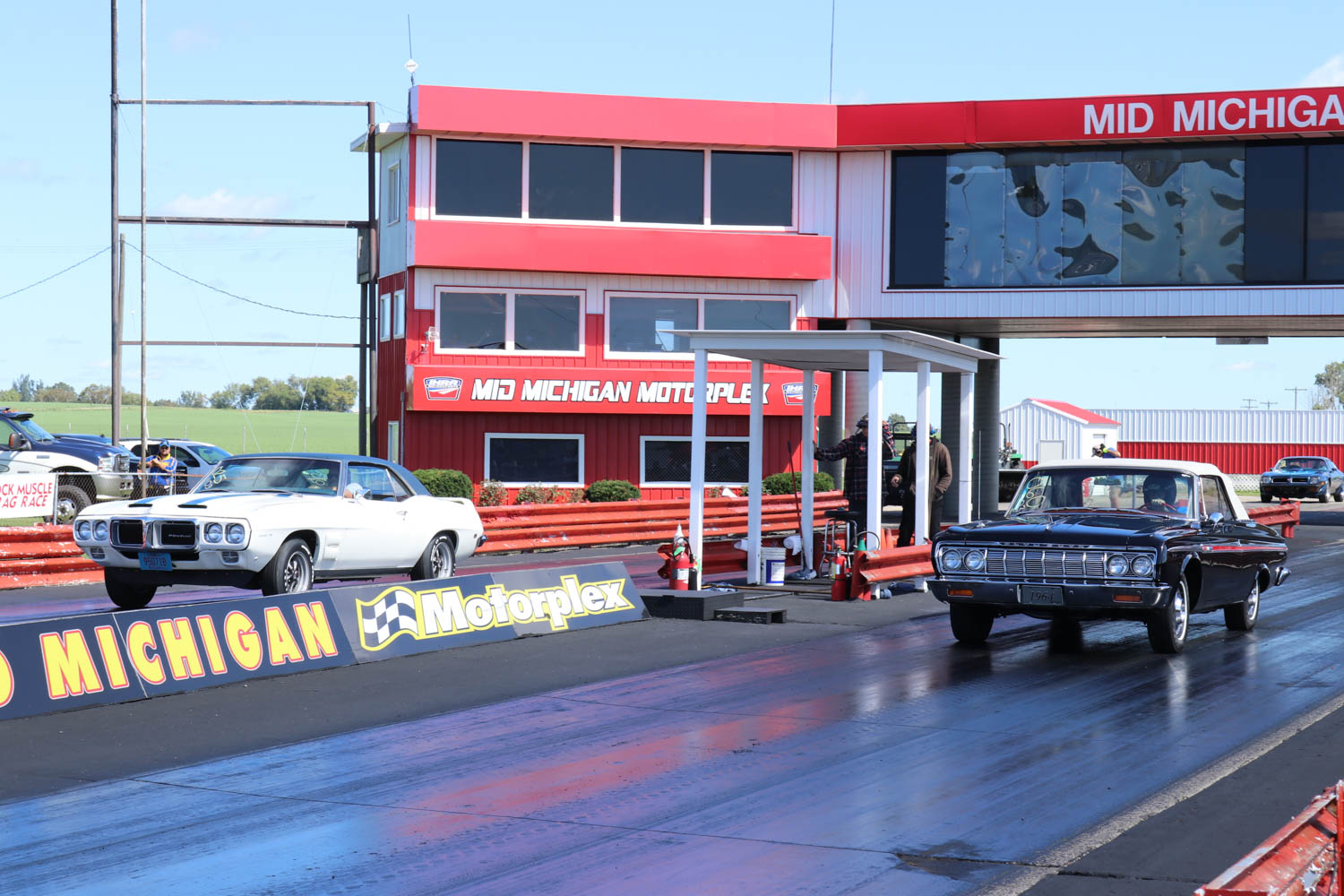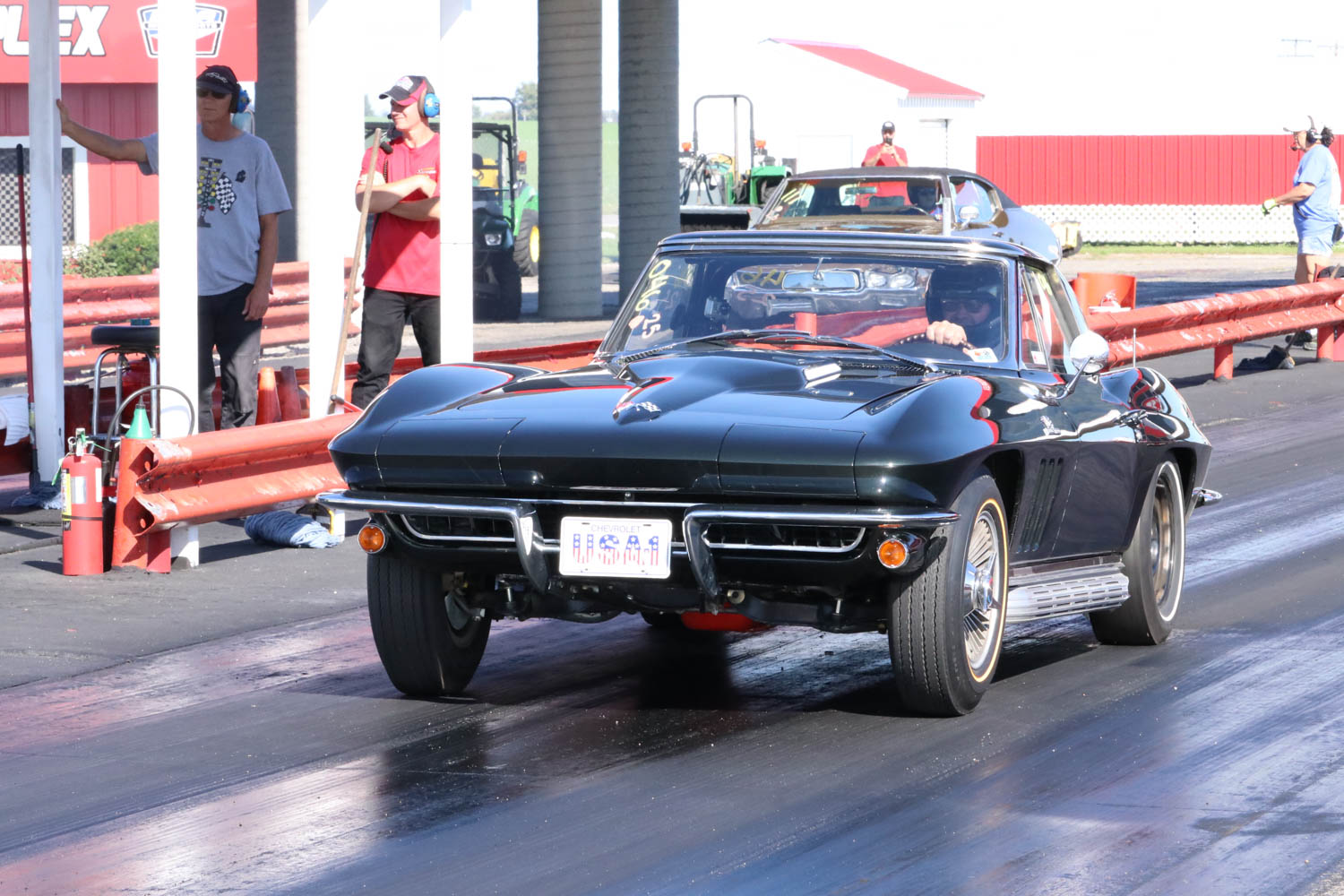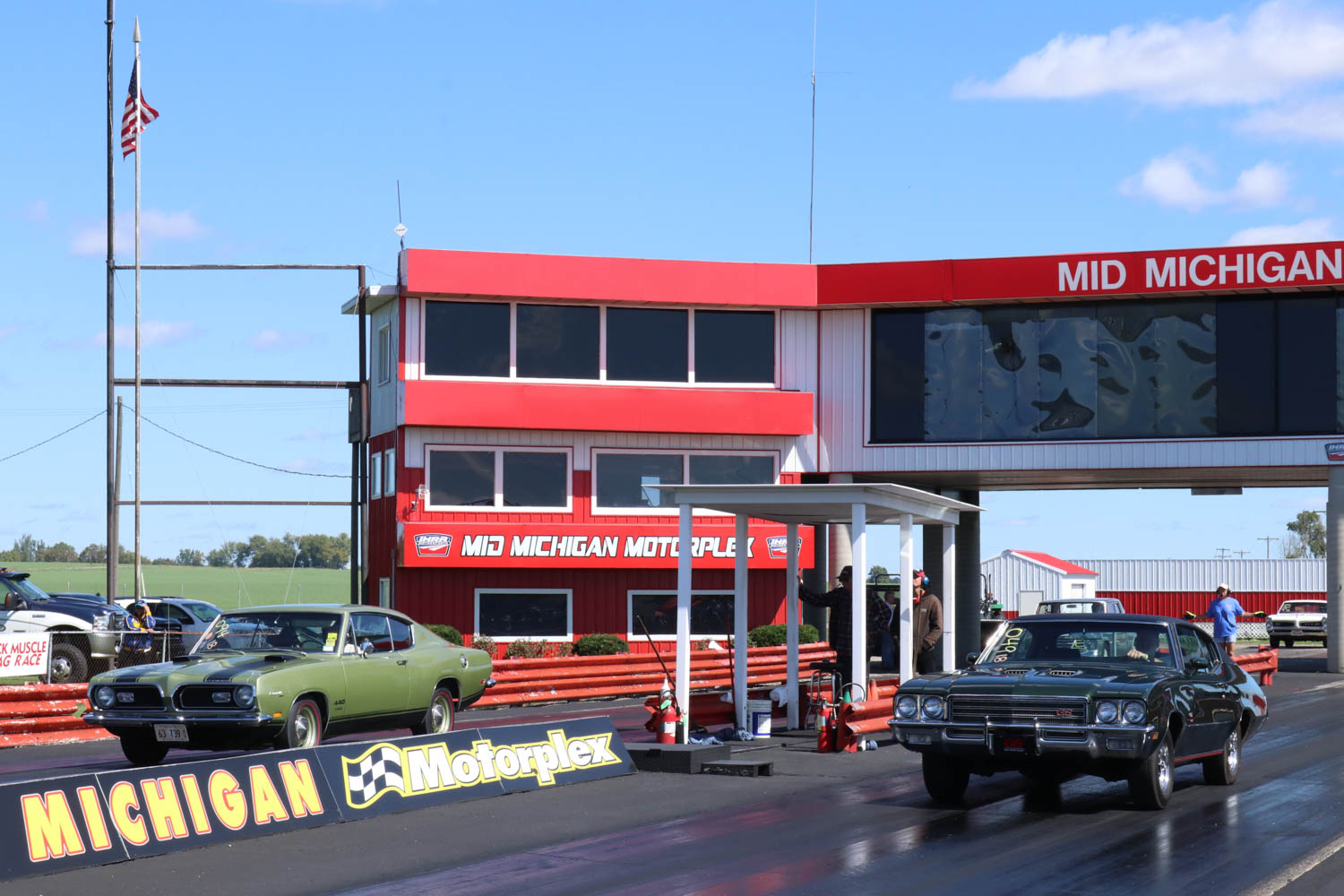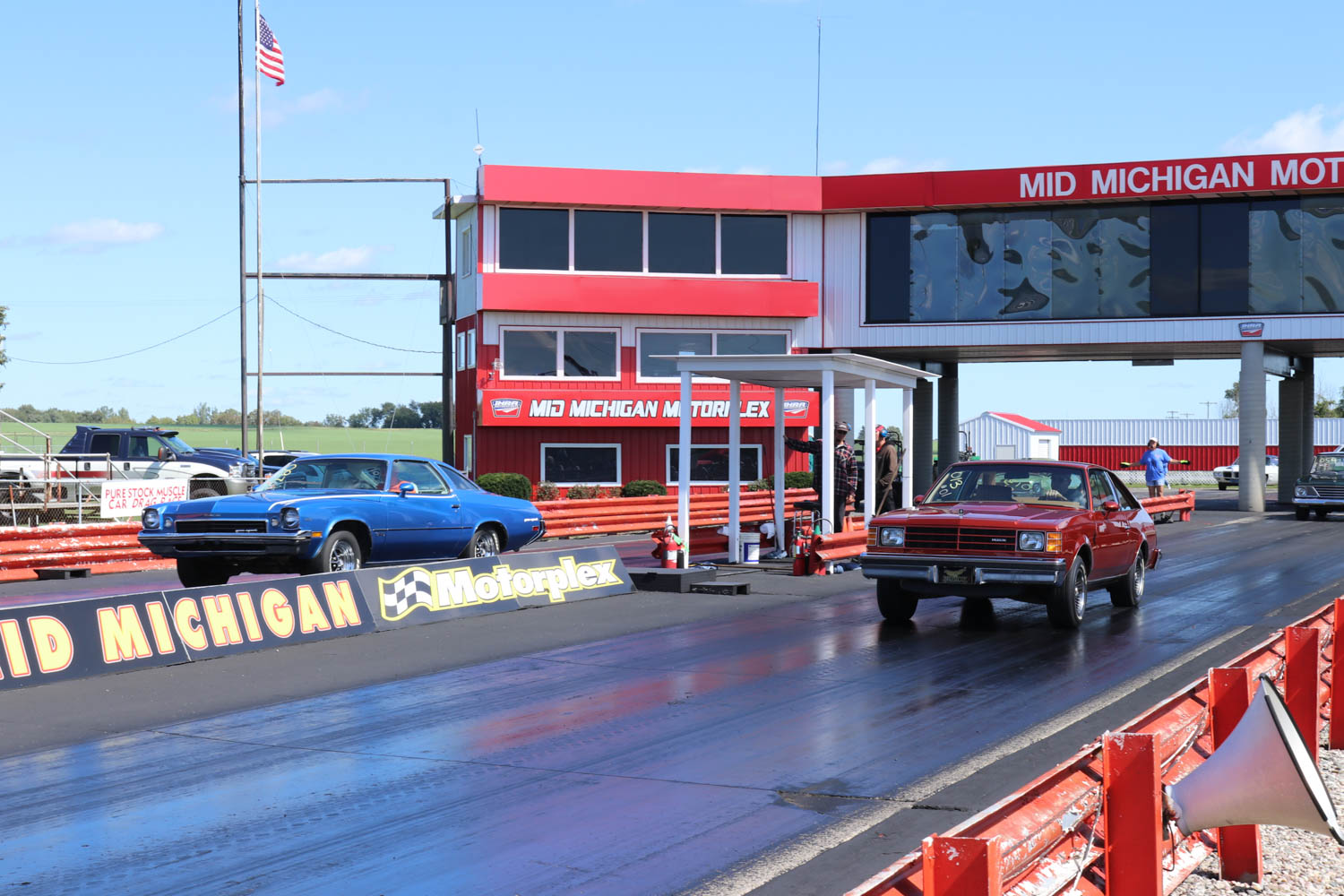Muscle car madness is a real drag in tiny Stanton, Michigan—and that’s a good thing
In the 25 years since it began, the Pure Stock Muscle Car Drag Race (PSMCDR) in tiny Stanton, Michigan, has grown from a handful of muscle cars to 115–130 year after year. Many of the participants started out as spectators and have evolved into racers, and it’s easy to see why.
PSMCDR rules aren’t complicated. They’ve evolved over the years and settled upon something akin to NHRA Stock, as long as compression doesn’t exceed the PSMCDR’s “1.5 over” compression rule. You’ll find cars that are showroom stock, as well as those who are maximizing every allowable advantage. The beauty of the event is that you’re paired with a vehicle that is running similar times, so in a sense, you’re competing against yourself, learning how to tune your vehicle and maximize its potential.
As the race’s reputation has grown, so has the excitement surrounding it. What vehicles will show up that haven’t competed before? What did so-and-so buy to race this year? Racers have even built cars just to see what they could do on the track, like the 1958 Mercury Medalist with a 400-horsepower, 430-cubic-inch engine that competed several years ago.
With those things in mind, let’s check out some of the new arrivals and drivers that hit the Pure Stock Muscle Car Drag Race for the first time last month:
1971 Chevrolet Chevelle SS 454

Troy Teichthesen is a veteran at NMCA, NHRA, and IHRA events, but 2019 marks his first time competing in the PSMCDR. “I’d been too several PSMCDR events as a spectator, as I love factory race cars and the history behind muscle cars,” he said. “After a little brow-beating from some buddies on how fast the Chevelle really is, I finally decided to bring it to Stanton. I didn’t know what to expect with tech and the people, but what I found was a great group of people that loved these old cars as much as me.”
Teichthesen bought the Chevelle from its original owner in 1981. The woman was in the military and ordered it with TH400 automatic transmission, tilt wheel, cruise control, 3.31 gears, and air conditioning, among other options. Paired with a 1971 Dodge Charger R/T with a 440 Magnum, the Chevelle had a plug wire issue during qualifying, but it was fixed in time and managed to pull a 13.71 ET at 101 mph—not bad for a bone-stock daily driver. Teichthesen also brought a 1965 Corvette powered by a 396, which ran 13.32 at 103 mph.
1969 Plymouth ’Cuda 440

Chicagoland resident Dave Doyle brought this rare Barracuda, one of 340 built with the 440 (all were automatics), which he bought as a high schooler in 1980 with proceeds from his pizza delivery job. A previous owner had added aftermarket air conditioning, a trailer hitch, and a CB antenna, as he used it to tow his camper through Wisconsin—an interesting fate considering the Barracuda is a car with manual steering, drum brakes, and 57 percent of its weight up front. Clearly the ’Cuda 440 was only meant for one thing—and it isn’t towing—so it was at home in Stanton. It wasn’t always welcome, however.
“I came out to watch this race starting in 2014 and met some of the racers,” Doyle said. “I knew I wanted to race, but I had to undo the camshaft, double pumper carburetor, and headers that I was running and return those items to stock.”
The ’Cuda is unrestored aside of a repaint, and Doyle is still running the original crankshaft, pistons, and rods. Within the rules of “stock,” he was running a Mr. Six-Pack stock cam, Manley Street Master valve springs, shift kit, 2.5-inch exhaust with performance mufflers, and 3.91 rear gears. Doyle said most of his elapsed times were in the 13.70s, with a top time of 13.61 at 101 mph.
1973 Buick Gran Sport

General Motors’ 1973 Colonnade coupes debuted when the government-mandated front bumper was phased in, adding another nail in the coffin of the high-performance (and collector) market. When a Gran Sport pops up, it’s usually a Stage 1, but Steve Caruso brought a 350-powered example. He’s been a stalwart presence at the PSMCDR, piloting a 1972 GSX clone for 22 years, but there “really was nothing more to gain with that car, so I thought I would try something different.”
Caruso flew out west to pick up the Gran Sport and brought it back to metropolitan Detroit. “I was really focused on getting the paint shined up,” he said. “The engine is a remnant of unknown origin. It has only 145 psi compression and don’t know what the cam is. Other than plugs, wires, Pertronix, and a carb rebuild, I’ve not spent much time on the engine other than adding a 2.5-inch exhaust. With lame 2.73 gears, and manually shifting [because the governor shifts to second at 4000 rpm], my first pass resulted in a 16.75 ET. Some carb tuning brought the ET down to 16.33 at 84 mph. Some passes I would hit the finish still in second gear or just making the shift to third.”
1969 Oldsmobile Cutlass S W31

Only 913 of these W-Machines were built, yet two were making their debut at the PSMCDR. Each has a unique story. Ryan Weaver had dreamed of competing at Stanton since reading event coverage in auto magazines in the 1990s. He began attending as a spectator in 2011, and then, in 2015, crossed over from the Chevy world and bought this dark green, 45,000-mile Sports Coupe (with the B-pillar) from the original owner in Ontario, Canada.
“Every piece of my car was restored or rebuilt with PSMCDR in mind,” Weaver said. “I made many decisions based on the rules. Even if roller rockers and roller lifters/cam are a low cost reliability item that could have easily been used during the engine rebuild, I stayed within the rules.”
This was Weaver’s first time ever down a drag strip. “My first ET was 15.98 at 77 mph and, over the weekend, I got faster and faster, eventually getting a low ET of 14.328 and a best mph of 97.” Not bad for a first-timer racing a small-block with 3.42 gears.
Back in 1999, Chris Smetana attended the Stanton event as a spectator and realized this is what he wanted to do with the Cutlass S Holiday (hardtop) Coupe he’d bought three years earlier. Alas, it was severely rusted, and life got in the way. However, he picked up an early 1970-1/2 Pontiac GT-37 with a 400 four-speed to tide himself over. “Four years ago I bit the bullet and started the frame-off restoration the car needed and deserved,” he said.
The Ram-Rod 350 was originally sold to a woman in Joliet, Illinois, who special-ordered the Olds in an exclusive Toronado color called Powder Blue. How did this automatic-equipped W31 compare to Ryan’s four-speed? With 4.33 gears, a best of 13.06 at 105 mph into a stiff headwind.
1966 Ford Fairlane GTA

Remember when Ford was parading the 390 and getting creamed by every competitor until the 428 Cobra Jet hit the streets in 1968? All that would have been forgotten if you saw this Fairlane on the track. It is owned by Mike McGee, who has been enjoying magazine coverage of the PSMCDR since the beginning. He’s been in attendance, “seeing all these beautiful cars being used as intended,” for the last few years.
About 10 years ago, McGee picked up the GTA and did a full ground-up restoration over that time, continuing to work on it hours before the race. “I did pretty much all the work on my own other than final bodywork and paint, engine machining, and brightwork-plating,” he said. As this was McGee’s first time racing at the event and he was prepping things at the 11th hour, he didn’t have much time to test and tune the 390. “To go faster, the only thing I tried was adjusting RPM shifts,” he said. “I wanted to change timing, but growing up around Ford FEs, I knew I was pretty close with 40 degrees total. I was planning on changing the jetting but accidentally left my carburetor stuff at home.”
McGee said most of his runs were in the 13.45–13.50 range at 100–101 mph, which helped give the 390 the glory it deserves.
1968 Chevrolet Chevelle SS 396

For years, Jim Maher has raced his 1967 Chevelle SS 396, which he’s owned since 1970, and his son Eric has raced a 1968 Camaro Z/28 since 2005. Last year, they found this largely original, 46,000-mile L78 375-horse Super Sport—it had been off the road since 1980—after it was willed to the original owner’s church. Eric said, “We did nothing to this car aside of pulling it from the barn, cleaning and polishing the paint, cleaning the interior, and installing the original carburetor, exhaust manifolds, and air pump (all of which were found in the trunk)—in addition to a minor tune-up and valve adjustment.”
It’s also one of the few that were built with a Buick interior, supposedly due to a strike. The Chevelle was originally built with code KM rear end sporting 4.56 gears but, for drivability, 4.10s have been substituted. Fastest time for the four-speed SS was 13.36 at 104.63.
1969 Pontiac Firebird Trans Am

Wisconsin resident John Eberle has raced 1969 and ’71 GTOs before at the PSMCDR in the past, but knowing that no 1969 Trans Ams have appeared, he decided to build his own, a replica of the four T/As built with blue vinyl tops.
“I’ve owned the car for three years—drove it off the trailer into the shop, and it was up and on stands and disassembly started two hours after it arrived,” Eberle said. “With help from Kent Fluegge on body and paint work, we finished about four weeks before the race.”
Eberle built the 400 to Ram Air IV specs, which required sorting out due to its freshness. “Mostly this was testing and shake-down for the car,” he said. “We did some minor timing changes, but most of the work was getting the shifter linkage set up so it wouldn’t lock up in second gear on a power shift. Still working on that little problem”—hence a best ET of 15.367 at 95 mph. “I know it can do better, and the goal next year is 14.0 or better.”
1971 Plymouth Duster 340

Dave Watt has raced an A12 440 six-barrel Road Runner and a 1973 Plymouth Duster 340 at Stanton in the past, but for 2019, he showed up with something new.
“In October, 2015, a Wisconsin Craigslist ad caught my attention,” Watt explained. “Even though it was a rolling shell, I brought it home to Atlanta, Indiana, and started the restoration the following year. I did all the work, including repainting it in factory GY3 Curious Yellow.”
The goal was to run a second faster than his ’73, so the compression ratio was increased, per the rules, from the factory 10.5 to 12.0. “I also installed a 4.30 gear, and finely tuned the suspension with replacement parts,” he said. “Now I’m able to run with quicker cars at this event and similar events across the country.”
Watt hit the drag strip earlier in the year and achieved 12.80s with his 340/TorqueFlite combo, but at Stanton he improved with 12.75 at 108 mph.
1968 Oldsmobile Hurst/Olds

Oldsmobile usually doesn’t have a large presence in Stanton, but this year it was littered with Lansing’s finest, including this 1968 Hurst/Olds owned by Luke and Michelle Krooswyk. Luke’s been a spectator since 2008 and had the intention of finding a car for the PSMCDR. Then, in 2014, they found this H/O as a complete project. It had been off the road for about 30 years.
“The wiring was a mess, interior was trashed, engine locked up, rear gears were missing teeth, etc.,” Luke explained. “On the plus side, the car had relatively low mileage, was solid overall, and had most of the original H/O parts.”
The Krooswyks methodically removed parts and restored them piecemeal with the intention of a frame-off, but those plans changed when they decided to have the car ready for the H/O’s 50th anniversary. Hence, glance at the pics and you’ll see a functional car with barn find patina.
“My goals were to run respectable times at the track with durability, while also being happy on street cruises,” Luke said. “A ton of attention has been paid to the details during the build, such as a blueprinted, 0.060-over 455 with the correct ‘D’ heads, stock 10.5 compression, 308-inch cam, competition valve job, 2.5-inch exhaust, plus aftermarket H-beam rods and a step-drilled oiling system for durability. Dyno testing and wide-band air/fuel tuning have also helped.” Luke run 12.82 at 106 mph.
What will 2020 bring to Stanton? We can’t wait to find out.






























